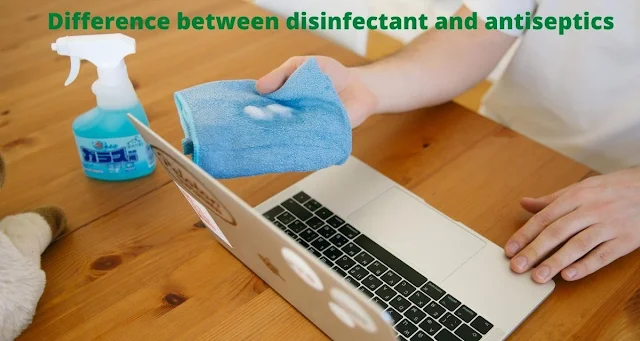Disinfectants vs Antiseptics: Understanding the Differences and Choosing the Right Product
What are Disinfectants?
Disinfectants are chemicals that are used to destroy harmful microorganisms, bacteria, viruses, and fungi on surfaces. Disinfectants are used to clean floors, seats, washbasins, utensils, machines, etc. They contain bleaching chemicals usually used for cleaning. They destroy microorganisms on inert surfaces or inactivate them. Disinfectants are unable to kill resistant bacterial spores. For resistant bacterial spores sterilization is required. Disinfectants are different from antibiotics which can kill microorganisms in the body. They destruct the cell wall of microbes by interfering with their metabolism. Disinfectants kill all types of life on surfaces where they are applied.
Disinfectants are much strong than sanitizers, sanitizers are used commonly for human hands sanitization or the things which come in contact with the human body. Sanitizers clean and sanitize the objects.
Only a few fungi, viruses, and bacteria show resistance to disinfectants. Although most can be removed by them.
 |
| disinfectants-vs-antiseptics |
Properties of Disinfectants
An ideal disinfectant should be safe in use for humans and animals, sterilization should be maximum on microbiological sterilization, and it should be non-corrosive and economical to use.
Some disinfectants are toxic and potentially harmful in nature to humans or animals. Domestic use disinfectants usually contain Denatonium, which is bitter in taste.
Types of Disinfectants
There are Several types of disinfectants are available in the market depending on the requirement, every location has specific requirements and structural layouts where a specific type of disinfectant can applicable.
- Chlorine-based disinfectants
- Alcohol-based disinfectants
- Quaternary ammonium compounds
- Phenols based disinfectants
- Hydrogen peroxide
- Peroxyacetic acid
- Air Disinfectants
- Aldehydes
- Oxidizing agents
Air Disinfectants
Air disinfectants are usually sprayed form of chemicals that are used to kill air microorganisms. The nature of chemicals may be different according to the need for a situation and the type of microorganism to kill. A simple mist of dilute bleach is enough to kill microorganisms in the air in some conditions.
This is usually used as vapors or in aerosol form. Very effective against microorganisms and safe for human Propylene glycols and Triethylene Glycols can be used where influenza virus, Penicillium chrysogenum, and other infectious viruses availability appears.
Alcohol disinfectants
Alcohol is a very effective disinfectant against all microorganisms and viruses, even in Corona's situation, alcohol-based sanitizers are in the top demand of the public. A 70% v/v ethanol solution in distilled water is a universal disinfectant, this solution is used all over the world in all pharmaceutical manufacturing companies to disinfect floors, microbiological pieces of equipment, machines, and many more.
An Isopropyl Alcohol 95% v/v solution is also a very prominent disinfectant when used against all bacteria, microorganisms, and microbiological bacterial growth.
Aldehydes
Aldehydes have wide microbiocidal activity and are sporicidal and fungicidal in nature. Formaldehydes are used to fumigate special areas where sterilization is required. All microorganisms, bacteria, and parasites. This practice is very popular in sterile areas like microbiological laboratories and Injection filling and preparation sections in Pharmaceutical manufacturing companies.
Oxidizing agents
The process where a microorganism’s cell membrane is oxidized by oxidizing agents is called oxidization. Oxidizing agents destruct the structure and lead to cell lysis and death of the microorganism. Chlorine and Oxygen are the most used oxidizing agents for disinfection.
Some other oxidizing agents are Anolyte (Electrolyzed water), Hydrogen peroxide, and Potassium permanganate.
Measurements of Effectiveness of Disinfectants
All disinfectants are understood as efficient if they perform against microorganisms or viruses. To evaluate the effectiveness of any disinfectant the effectiveness test is carried out against Phenol as a standard Disinfectant. The corresponding rating system is called the Phenol coefficient.
What are Antiseptics?
Antiseptics are antimicrobial substances used to kill germs, and microorganisms on the skin to prevent infections and sepsis. Antiseptics are similar to antibiotics in killing bacteria or infections, antibiotics kill bacteria inside the body however antiseptics kill outside bacteria on the body's skin or tissues.
Where some antiseptics prevent the growth of bacteria and work as bacteriostatic, rather some destroy microbes like germicides. This is the main difference between disinfectants and antiseptics because disinfectants kill the microbes and stop them to regenerate again.
Antiseptic definition microbiology
An antiseptic is a type of disinfectant, which kill or stops the growth of microorganisms on living bodies called antiseptic microbiology is a chemical preparation that is used to eliminate germs and is known as antiseptic. Hydrogen peroxide is a good example of an antiseptic.
Antiseptic spray
Antiseptic sprays are chemicals prepared to protect against infections on cuts, grazes, and animal bites. Small wounds, burns, etc, are filled in spray bottles that can apply fast on target places of the body. These are very helpful in First Aid processes. There are different types of antiseptic sprays which are Dermoplast First Aid Spray which is a human antiseptic spray. Pac-Kit by First Aid Only 13-030 First Aid Alcohol Antiseptic Spray, BAC-D Antibacterial Foaming Wound Sanitizer.
Some more antiseptics are povidone-iodine, chlorhexidine, alcohol-based solutions, and cetrimide.
How do you make antibacterial sprays?
You can prepare antibacterial spray at home without costing a big amount, In a mixer takes distilled or DM water add some vinegar, add some drops of the lavender, and mix for 30 seconds, now let it settle down its foaming, then replace the whole solution in a spray bottle, now you can clean any place or home.
Antiseptic spray for wounds
Hansaplast antiseptic spray is most commonly used in wounds and cuts for first aid purposes. It cleans wounds through mechanical irrigation. It is a colorless solution with Fast and pain-free application.
Antiseptic spray for dogs
In India, antiseptic spray available for dogs is a popular brand is Scavon’s by Himalaya, which is a bactericidal action that controls infections. The spray’s antifungal property is responsible for effectively treating and preventing the recurrence of fungal infections. Supportive in sarcoptic and psoroptic mange.
Types of antiseptic
- Alcohol-based antiseptics
- Chlorhexidine
- Povidone-Iodine
- Hydrogen peroxide
- Benzalkonium chloride
Alcohols
Ethanol 70% and IPA (Iso Propyl Alcohol is top antiseptic, these are also called surgical spirit, ethanol, and IPA are two universal disinfectants and antiseptics used in all pharmaceutical and pathological uses.
Chlorhexidine gluconate
Chlorhexidine gluconate is widely used as a mouthwash to kill germs in the mouth and odor of the mouth, this is also used on skin as an antiseptic.
Chloroxylenol
Chloroxylenol is an antiseptic, which is used in big brands of antiseptic in their composition, it is a disinfectant also, widely used in hospitals and pathology laboratories to clean used instruments.
Hydrogen peroxide: Hydrogen Peroxide is a primary antiseptic used everywhere in hospitals, and clinics to sterilize medical equipment and to cleanse wounds and skin before administration of a syringe in the skin. This is used in 3% v/v strength in general conditions.
Iodine: The iodine solution is widely used in postoperative surgeries to clean wounds and stitches.
Octenidine dihydrochloride: Octenidine dihydrochloride is widely used in place of chlorhexidine gluconate, this is used in European countries.
Polyhexanide: Polyhexanide is a strong antimicrobial agent which is utilized as an antiseptic in chronic wounds that are acutely infected. The application of Polyhexanide stops the development of resistant bacterial strains.
Urinary antiseptic types: Methenamine and nitrofurantoin are two top-used urinary antiseptics, these are used worldwide as antiseptics in urinary places.
Differences between disinfectants and antiseptics
- Usage: Disinfectants are used to clean surfaces, objects, and things that are not living like tables, cupboards, pots, etc, while antiseptics are used to kill the microorganisms in living spaces like human skin and living tissues.
- Strength: Disinfectants are more stronger and able to kill bacteria than antiseptics because they are manufactured in such a way as to kill bacteria in a broader range of microorganisms on surfaces. Antiseptics are designed to apply on human skin for killing microorganisms.
- Safety: Disinfectants are harmful if they are applied on human skin, they have more high concentration of agents, while antiseptics are safe on human skin or living tissues.
Summary
Disinfectants and antiseptics are very close to each other in their application. The difference between disinfectants and antiseptics is very narrow and specific. Many times disinfectants and used in place of antiseptics and antiseptics can be used in place of disinfectants in specific conditions. Since disinfectants are highly concentrated chemically, they should not be used in place of antiseptics. The selection of antiseptic is very important as per its application.
References:
- ScienceDirect Website (Suzuki, J. B., & Misch, C. E. (2018). Periodontal and Maintenance Complications. Misch's Avoiding Complications in Oral Implantology, 771-826. https://doi.org/10.1016/B978-0-323-37580-1.00018-4)
- CDC- Centers for Disease Control and Prevention
- Disinfection, Sterilization, and Preservation" by Seymour S. Block [READ]
- Disinfection and Decontamination: Principles, Applications, and Related Issues" by Gurusamy Manivannan- [ONLINE REF.]




Please not enter any spam link in the comment box.